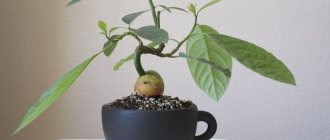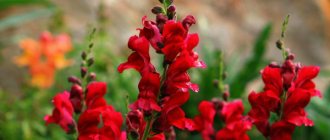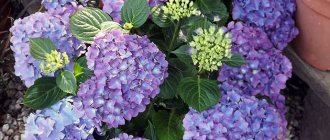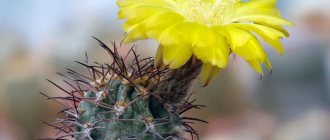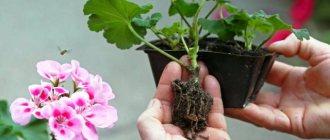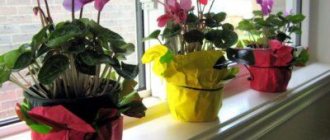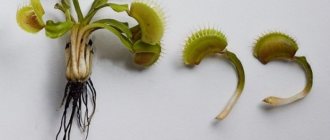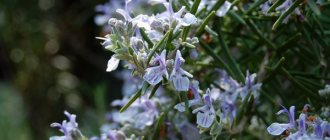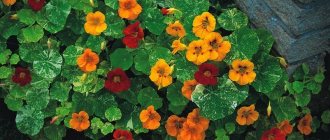Cyclamen is a small plant that gardeners successfully grow from seeds at home. Of course, it’s easier to buy it in a store or ask friends. But such an opportunity is not always available. Then those who want to keep this flower at home can only sow and grow it with their own hands. And we will help you by telling you how to do it correctly.
Description, types and varieties
Cyclamen is a perennial herbaceous plant from the Myrsinaceae family. It is also called alpine violet or woody violet. In the wild, it grows in northeast Africa and East Asian countries, as well as in the Mediterranean.
Cyclamen has a hidden tuber underground, from which new rounded leaves on long petioles grow from year to year. They are dark green in color and often have a striped pattern of light silver lines. During the flowering period, cyclamen forms many long peduncles rising above the rosette of leaves. And bright flowers with an unusual shape bloom on them. Their color depends on the type and variety of the plant. After flowering ends, the leaves fade and a dormant period begins, which lasts up to 5-6 months.
There are about two dozen species of cyclamen, but only two of them are grown at home:
- European;
- Persian.
These two flowers are very similar in appearance, but still have the following differences:
- Tuber . In the Persian, it looks out of the ground by about 1/3. But for a European it is hidden by the ground.
- Leaves . In the Persian the back of the leaves is green, while in the European it is blue-green or green with a purple tint.
- Bloom . In the Persian it begins at the end of October and lasts until the end of March (winter), while the European blooms from late spring to mid or late autumn (summer).
This is interesting! Species cyclamens form fruits - boxes. The seeds they contain look like buckwheat grains.
Both European and Persian cyclamen have several varieties, distinguished by different shapes and colors of flowers. Let's give examples of them with photos.
Varieties of Persian cyclamen:
Varieties of European cyclamen:
Cyclamen - what kind of home flower is it?
Cyclamen belongs to the Mirsinov family and is a herbaceous perennial with a tuberous system that ensures the viability of the entire plant. Its homeland is the Mediterranean region, Central Asia and eastern Africa. Here the climatic conditions are most favorable for it.
What does cyclamen look like?
For your information! In the central zone, cyclamen does not grow in open ground. But this did not stop lovers of original house plants from domesticating the crop and turning it into an indoor flower.
Standard cyclamen sold in stores has the following parameters:
- the root system consists of a thick tuber and a short underground stem;
- the above-ground part consists of small shoots and leaves, which are ovoid or rod-shaped in shape. They grow from the very base. The leaf blade can be gray or rich green. There are varieties with both single-color and two-color colors. Moreover, two-color can manifest itself in spotting or the presence of edging;
Different plant varieties
- the flowers are solitary, they are located at the end of a long peduncle. At the same time, the plant produces several of them, on average from 5 to 15. The released shoot with a bud is twisted into a spiral, but as it grows, it unwinds, and a drooping flower is formed at the end. Cyclamens can come in a wide variety of colors, either monochromatic or with a combination of several shades;
- In shape, the petals form a five-part cup with a corolla. The shape of the flower is correct, the petals are bent back;
- At the end of flowering, a spherical fruit box is formed. It contains many seeds separated from each other by valves;
- The average height of the plant varies around 20-30 cm.
Note! An interesting fact is that some varieties of this plant do not form foliage, but immediately throw out a shoot with a flower bud.
Cyclamen at the moment of bud formation
When to sow seeds for seedlings
Cyclamen seeds take a very long time to germinate - this can take from 1 to 3 months. Therefore, the planting time must be calculated so that seedlings appear in the spring, when the sun's rays become brighter and the length of daylight increases. In this regard, it is better to sow seeds for seedlings in the second half of winter (January or February), regardless of the region of the country in which you live.
Attention! Pre-soaked and swollen seeds germinate faster, so they need to be planted at the end of February, while dry ones take longer to hatch. Therefore, they can be planted at the end of January.
Step-by-step disembarkation
Sowing begins with the preparation of the necessary components and the planting material itself.
It is important to follow the instructions so that planting cyclamen seeds at home will end in success. Be sure to select the correct soil and container, as well as process the material
Preparation of material
Preliminary preparation of seeds will help to plant the plant correctly. There are several ways to do this:
- Soaking with Fairy or other dishwashing detergent. Add a few drops of detergent to a container of water and immerse the material. The container should stand for three days, and the liquid should be replaced with fresh one every day.
- Potassium permanganate. To make the solution, several manganese crystals are poured with water at room temperature so that the liquid becomes slightly pinkish in color. The seeds are soaked for about 15 hours.
- The third option involves the use of special preparations that can be purchased at the same flower shop. The instructions for their use are usually found on the packaging.
- And the easiest way is to simply fill the planting material with cold water for a day.
Soil selection
The soil should be light so that it is easier for seedlings to break through. You can purchase it in specialized departments or try mixing it yourself.
If you want to use the second option, then peat, which is combined with leaf humus in a 1:1 ratio, is suitable for this purpose. After which the resulting mixture is sifted, removing dirt and larvae, and disinfected. Again, there are several ways to do this:
Calcination. Can be done in the oven or microwave. The soil is poured onto a baking sheet or into a bowl with low sides and placed in the selected unit. Exposure time is 10−15 minutes. Use of steam. Steaming is also an excellent option; a water bath is suitable in this case.
But it is important to remember that after the procedure the soil should stand for at least a week and only then be used. Treatment with potassium permanganate. Pour a hot solution of manganese into the soil and allow it to dry completely.
Planting process
When starting this stage, the work surface is covered with oilcloth, and gloves are put on your hands, although this is not necessary. For work you will need: a container (it is better to take a square one, not very deep, but wide), soil, water, seeds and a lid for the greenhouse. The process itself is as follows.
- Holes are made in the bottom of the box if they are not provided for in the design.
- The first layer is polystyrene foam or pebbles.
- Next, evenly sprinkle soil on top with a layer of 5-6 cm.
- The soil is moistened with water.
- Seeds are placed on damp soil at a distance of at least 3 cm from each other.
- Soil is again poured on top, but the thickness of the layer should not exceed 1-2 cm.
- The last step is to spray the soil with a spray bottle. This is necessary to moisten the soil, but at the same time not wash it away.
This completes the sowing. All that remains is to cover the box with glass and put it in a cool place.
How to prepare seeds before planting
Dry seeds can take up to 3 months to germinate. But the process can be speeded up by preparing them correctly:
- Pour cool or lukewarm water into a glass and dissolve 1 tbsp in it. l. salt with a slide.
- Pour the seeds into the saline solution and stir them with a spoon for 5 minutes.
- Some seeds will float, while others will settle.
- Drain the floating seeds - they will not sprout.
- Soak the remaining seeds in a cloth or cotton pads soaked in cold water and leave them in a cool place for 3 days.
- Prepare a solution of potassium permanganate and moisten a new cloth with it. Place the seeds in it and leave for another 3 days.
Advice! Experienced flower growers recommend using special growth stimulants - Epin, Zircon or Kornevin - instead of potassium permanganate. Seeds soaked in them increase their germination rate, germinate faster, and produce stronger and more viable sprouts. Moreover, you need to soak in the stimulant solution not for 3 days, but for 15-16 hours. For 1 glass of water you need to take 1-2 drops of the drug (see instructions).
Planting process
Following the step-by-step guide for planting seeds will ensure the best result, expressed in the fastest germination and full formation of the root and leaf-stem systems of the flower.
Before planting, you need to carefully check the seeds for suitability for further use.
Pay attention to the remains of the seed cover, which sometimes prevents the free development of new leaves. In some cases, it may be appropriate to remove the remaining portions of the seed coat yourself.
This manipulation can significantly accelerate the further growth of the seedling, but you should be careful - young shoots are extremely fragile
A layer of expanded clay or small pebbles is laid out at the bottom of the pot. The layer thickness is 2-3 cm. In the absence of these materials, you can use clean sand. This is necessary to ensure good hydraulic permeability, which prevents siltation of the soil, and to create an air cushion, since cyclamen needs a sufficient amount of oxygen.
Next, the soil prepared in advance is poured
At the preparation stage, it is important to exclude the entry into this soil of seeds of other plants, as well as pest larvae, which can spoil the undeveloped flower tuber
The height of the soil layer should not reach the top edge of the pot by 2-3 cm. The remaining distance to the top will be needed to place a sprout in it, which is placed in the center of the pot and sprinkled with earth.
The soil around the stem must be laid in such a way that some part of its trunk and the emerging leaves remain above the surface of the earth. The space left to the top edge of the pot is necessary to create a greenhouse effect.
This effect is achieved by covering the pot with film. This is done until the height of the flower exceeds the level of the side. When the plant grows more and more, it begins to rest against the film, it should be removed.
The film blanket is not used all the time. It needs to be removed periodically so that the plant can “breathe” and not burn out in an improvised greenhouse. At the moment of opening, the pot is placed on the window, where indirect rays of the sun can nourish the young cyclamen and start the necessary processes in it.
What you need to grow seedlings
To propagate cyclamen by seeds you will need the following materials and tools:
- container (what it should be, we already said above);
- nutritious and loose soil mixture;
- drainage material (pieces of polystyrene foam or perlite);
- shoulder blade;
- gloves;
- water and a spray bottle for watering;
- film or glass.
To care for seedlings, you will also need individual cups with drainage holes, a picking stake and new soil. Later, when the seedlings get stronger and begin to grow actively, you will need to purchase mineral fertilizers.
What you need for self-sowing
To independently propagate cyclamen from seeds you will need:
- high-quality seed material purchased in a store, from flower growers who grow this plant, or obtained independently from a home flower;
- growth stimulants - Etamon, Epin or Zircon;
- ready-made earthen substrate, or peat, clean calcined river sand and leaf soil;
- drainage material (expanded clay, pebbles, etc.);
- opaque film;
- a watering can with a fine strainer or a spray bottle;
- mineral fertilizer;
- seedling box for sowing seeds.
Conditions for seed germination
In order for the seeds to germinate, they need to create optimal conditions for germination.
Temperature
Cyclamen is an unusual plant that germinates faster when the air is cool. In order for the first shoots to hatch 30-40 days after sowing, you need to keep the temperature at +14...+16 °C. If it is higher, it will take longer.
Lighting and location
Until the seeds have sprouted, they should be kept in the dark. You can place the bowl in any place with a suitable temperature and cover it with dense material that does not allow light to pass through.
Air and humidity
For seedlings to emerge, it is important that the air is constantly moist. It is optimal for the humidity level to be 85-95%. It is easy to maintain by using film or glass to cover the bowl with the planted seeds.
Basic mistakes
When growing cyclamen from seed material, it is necessary to take into account the main mistakes made by inexperienced gardeners:
- The soil must always be moist so that the seeds do not dry out;
- It is necessary to water daily , but in no case should water stagnate;
- To avoid drying out, you can cover the seedlings with glass , while not forgetting the need for ventilation;
- During the first 3 months, cyclamen roots grow rapidly , leaves appear later;
- The indoor cyclamen tuber has only 1 growth point , damage to which can lead to the death of the entire flower;
- The plant needs to be fed only after the first half of the year , using a weak solution of fertilizer for flowering plants.
Sowing seeds
Sowing cyclamen seeds step by step:
- Scald the seedling bowl with boiling water, heat the soil in the oven and cool.
- Place torn pieces of foam or perlite at the bottom of the container. The thickness of the drainage layer should be approximately 1 cm.
- Fill the bowl with soil and lightly compact it, moisten it generously. The optimal soil thickness is 5-6 cm.
- Spread the seeds on the surface of the soil in a 2x2 or 3x3 cm pattern.
- Pour another 5-10 mm of soil on top and spray it generously so that the water reaches the seeds themselves.
- Cover the bowl with glass or film and place it in a place with conditions suitable for germination.
Until the first shoots emerge, the bowl must be opened every day to prevent the soil from becoming moldy. Condensation from the shelter should be removed, and the soil, if necessary, should be moistened with a spray bottle.
Cyclamen: growing from seeds and care at home
How to grow cyclamen at home so that it will delight you with long and abundant flowering? It is important not only to correctly plant seed material in the ground, but also to properly care for the seedlings.
Preparation of soil and material
Before you start planting seeds, it is worth preparing the seeds. For this purpose, you need to fill the planting material with a 5% sugar solution. Floating seeds can be thrown away without regret, and those that have sunk to the surface of the bottom of the container will be required for planting. After the seeds have been removed from the sugar solution, they must be kept in one of the following products for 24 hours:
- Epin solution;
- potassium permanganate;
- Zircone.
Before planting cyclamen, it is worth filling the container with light soil. If necessary, you can prepare the substrate yourself by combining a small part of leaf soil and peat or vermiculite and peat. The substrate can also be prepared from:
- leaf soil - humus of wood leaf plates;
- peat or peat soil;
- sand that does not contain any admixture of clay.
The sand is thoroughly washed and cleaned of unnecessary components such as silt or pieces of clay and shells. Sand dilutes the soil and prevents it from caking, thereby facilitating the penetration of oxygen into the soil.
Note! Growing cyclamen from seeds is a very exciting process that even inexperienced gardeners can handle if desired.
Before pouring the soil mixture into the container, it is worth pre-calcining it.
Each of the components of the soil mixture must be mixed in reasonable quantities. Too much of one or another component or fertilizer can negatively affect the structure of the seeds and reduce the chances of germination.
It is unacceptable to add components to the soil that continue to support the rotting process. Against this background, the process of intrasoil heat release begins, which is why the seeds can “burn out.”
Draper seeds
The planting container should not be bulky, as the plants need frequent replanting. When planting seed material in plastic pots, you should take care in advance to make holes in the surface of the bottom of the container using hot nails. For this purpose, the nail is held over the fire for about 30 seconds. You can hold it with pliers, which will make it possible to avoid burns. The bottom of the pot is pierced with a hot nail in several places.
A drainage layer, the thickness of which reaches 2 cm, is poured onto the bottom surface. Styrofoam or expanded clay are ideal for drainage. After this, a layer of earthen mixture (about 7 cm) is poured into the pot. The soil is abundantly moistened.
Planting seed material in the ground
Below is a step-by-step process for planting dryer seeds.
- Cyclamen seed must be sown on the surface of moist soil.
- It is necessary to pour a small layer of soil on top of the planting material.
- In order for the seeds to germinate, you need to place the pot on the windowsill near adult alpine violet bushes.
- The container is covered with a layer of film (opaque). The room temperature should be within +22..+25 degrees. Compliance with the temperature regime will speed up the process of seed germination. When the temperature drops below +18 degrees, the planting material will begin to rot in the ground.
- The film should be systematically removed from the pot for ventilation, and the soil mixture should be moistened.
- Soon shoots will appear, which are small nodules from which loops of shoots with petals unfold. The loops are painted in bright purple tones.
Note! It is important to control the condition of the top layer of soil - it should not dry out. That is why gardeners recommend watering every day, but using less water. At the same time, stagnation of water should be avoided.
How to plant cyclamen in another way? Some gardeners recommend that after planting the seeds in the soil mixture, move the pot to a shaded room that receives virtually no sunlight.
Problems may arise when seedlings emerge. The skin of the seeds may not be removed, which does not allow the leaf to fully unfold. As a rule, after a certain period of time the problem resolves itself. In some cases, assistance may be required. To do this, you will need to cover the sprouts with a moistened cotton pad for 60-90 minutes. After this, the seed will be well hydrated. Now you can remove the peel using tweezers without damaging the sprouts.
Cyclamen shoots
Features of caring for seedlings
Alpine violet seeds are characterized by slow germination. It is worth being patient and systematically moistening the soil mixture and removing the film for ventilation.
Before emergence, it is worth watering the soil with a spray bottle. The soil after the moistening procedure should be moist, but not wet.
Note! To avoid rotting of the tubers from waterlogging, you can pour water for irrigation into the pan. The temperature of the irrigation liquid should be room temperature.
The emergence of seedlings should be expected 30-45 days after the seeds were planted. As soon as the seedlings appear, the film is removed and the pot is placed in the most sunny place in the apartment. The temperature can be reduced to 20 degrees.
As soon as the 3rd leaf plate has time to form on the seedlings, it is worth picking them up into separate containers. To plant seedlings, you should use a self-prepared soil mixture, which consists of:
- leaf soil;
- peat;
- a small amount of sand.
After picking, it is recommended to sprinkle the tubers with a layer of soil. After 7 days, you can add flower fertilizer to the soil. Flower growers recommend using:
- 0.2% ammonium sulfate solution;
- 0.1% potassium nitrate.
After several months of growing seedlings, you can plant each bush in a separate pot. It will take 14-16 months to wait for the first flowering after the seeds have been sown.
Recommendations regarding the timing of picking
Experts recommend adhering to the rules for picking, which are presented below.
- Carrying out 1 pick should be carried out at the moment when 2-3 leaf plates are formed on the bushes. You can place several seedlings in one pot at once.
- The second pick can be carried out after 6 months. The seedlings are placed in separate containers filled with loose soil.
Note! During the second picking, it is worth leaving a third of the tuber under the ground.
Alpine violet needs systematic watering
Seedling care
After the emergence of seedlings, the conditions of maintenance need to be changed. The main thing is to do this on time, before the sprouts stretch out.
Temperature
After the emergence of seedlings, the bowl should be placed in a place with a temperature of +18...+20 oC. If you germinated the seeds at a higher temperature, there is no need to lower it.
Seedling lighting
Cyclamen need a lot of light, but it must be diffused. Therefore, the seedlings should be placed on an eastern windowsill, or on a southern one, if you will protect it from direct rays of the sun at noon. You can put it in any other place if you provide adequate artificial lighting. For this it is better to use special phytolamps. The optimal duration of light for Persian cyclamens is 12 hours, and for European ones – 14-16 hours.
Watering seedlings
Newly hatched seedlings have a very weak root system. Therefore, the soil should not be allowed to dry out. As soon as you see that it begins to dry out, immediately spray it with a spray bottle.
Feeding seedlings
Before picking, seedlings do not need fertilizing. It has enough nutrients contained in the soil.
Picking seedlings
Picking seedlings is done 3-4 months after emergence. Step-by-step description of the procedure:
- Prepare seedling cups. They should be small (about 5-6 cm in diameter and 6-7 cm in height), since cyclamens do not grow well in large containers.
- Place some pieces of foam or perlite on the bottom.
- Fill the cups with the same soil mixture you used to germinate the seeds.
- Water the bowl with the seedlings generously.
- Make a depression in the center of the soil in the cups.
- Using a picking peg, remove one sprout and carefully place it in the formed recess and cover it with soil.
- Water the seedling.
- Do the same with the remaining sprouts.
There is no need to trim the roots of cyclamen. During the picking process, they will already suffer some damage.
Pinching seedlings
Cyclamen seedlings do not need pinching or pruning. Every year the plant forms a new rosette of leaves from the tuber.
Where to get seeds
How to water cyclamen - care rules during flowering and dormant periods
If possible, you can collect seeds from an adult plant. In this case, you need to follow several basic rules:
- make sure that the mother plant is not diseased or infected. Otherwise, the collected seeds will either have low germination, or they will grow into a weak plant that will not fully bloom;
- the second point that is important to consider is the correct time to collect seeds and the presence of two flowers in close proximity.
Important! In order for cultivation through seeds to be effective, it is necessary to correctly manipulate the fertilization of two plants. Otherwise, seed material will have to be purchased at a specialized store.
Artificial pollination method to obtain seeds from another flower
Without cross-pollination, it will not be possible to obtain full-fledged seeds. Therefore, in the absence of insects, it will be necessary to take pollen from one cyclamen during flowering (from December to February) and treat the second plant with a brush. Moreover, to ensure the reliability of the procedure, it must be repeated at least twice. Then, when the buds fade, boxes form in their place. There is no need to open them manually. They themselves must burst. It is important not only not to miss this moment, but also to prevent the scattering of seeds. As soon as the box begins to crack and turn yellow (this will happen by the end of spring), it is torn off and the cyclamen seeds are manually shaken onto a sheet of paper.
Box with plant seeds
Diseases and pests of seedlings
Pests rarely attack cyclamen seedlings. But it still happens. Aphids, thrips and cyclamen mites love to feast on the juice of its leaves. If insects appear on young plants or eaten away areas on the leaves, you will have to use insecticides (Aktaru, Karbofos, Inta-vir).
Much more often, cyclamen seedlings suffer from diseases. Usually it is affected by fungal infections and rot due to regular waterlogging of the soil, stagnation of water in it and poorly constructed drainage. Moderate watering as needed will help prevent infection of seedlings, and treatment with a fungicide can save them after the first signs of infection appear. Flower growers recommend using a 0.2% solution of Fundazol for this purpose.
Further care
After picking, it becomes easier to care for the seedlings, since their root system is actively developing and small errors in care are no longer so scary for them.
Watering
Cyclamen should be watered with settled water. To prevent the leaf rosette from rotting, you need to pour water into the soil, and not onto the tuber. The flower loves water very much, but it should not stagnate in the pot. If the soil allows moisture to pass through well, then you should water more often, as the water will go into the pan. General recommendations are as follows: the soil should not be allowed to turn into a lump from dryness.
In hot weather, cyclamen should be sprayed early in the morning from a spray bottle placed at a distance of 20-30 cm from the flower. This will help prevent moisture from accumulating on the stems and top of the tuber.
Top dressing
The first feeding is carried out 2-3 months after picking. To do this, you should use complex mineral fertilizers for flowering plants. It contains many substances that are necessary not only for flowering, but also for the formation of the tuber and root system. But you need to take 2 times less fertilizer compared to the dose indicated on the package. The frequency of fertilizing is once every 2 weeks during the period of active growth or flowering.
Loosening, mulching
If the soil becomes dense, it must be loosened carefully.
Pinching, pinching, pruning
Cyclamen does not require the formation of a bush; it independently forms a leaf rosette. However, during the flowering period, if you do not need the seeds, it is better to remove the stems from faded flowers.
Transfer
Cyclamen should be replanted every year after the end of the dormant period, when the first buds begin to bloom on the tuber.
How to grow cyclamen: features of growing cyclamen
Keep it cool
Cyclamen does not like heat, the ideal temperature for it is only 16 degrees Celsius, it is in such conditions that this flower will bloom. In summer, the permissible “living” temperature for cyclamen is about 20 degrees.
If the temperature is high, the flowering plant purchased will fade very quickly without releasing new buds.
It is advisable to place the flower on an eastern or western windowsill.
Provide light and air
Cyclamen loves fresh air (but does not tolerate drafts) and good lighting (but not the scorching rays of the sun).
Proper watering
Cyclamen is moisture-loving, and at the same time does not tolerate watering on the leaves or on the tuber. And the ingress of water onto the growth point of the cyclamen tuber is especially critical. So the ideal option would be bottom watering into a tray. After filling the tray with water, you need to wait about 15 minutes and check that the water has risen to the top layer of the substrate in the pot. As soon as the top layer is moistened, the excess water is drained from the pan. You cannot leave excess water in the tray; this water will be absorbed through the drainage holes of the pot (until it is completely absorbed), and this can cause excess moisture in the substrate and rotting of the cyclamen tuber.
It is important to water this plant with soft, settled water (ideally rainwater); it also does not tolerate soil salinity.
Toward the end of flowering, it is necessary to reduce watering so that the plant prepares for dormancy.
Spraying
Cyclamen loves high air humidity, so outside of flowering it needs to be sprayed regularly, and during the appearance of buds and flowering, provide humidity in other ways (spraying on the buds can cause their rotting and death).
You can, for example, fill a container with pebbles and fill it with water, place a pot of cyclamen on top of the stones, and make sure that the bottom of the pot does not touch the water in the container. The purpose of a tray with stones is to evaporate water from the stones and humidify the air around the flower.
Don't forget about fertilizers
Once every couple of weeks, you need to add fertilizer in a small amount to the water for irrigation (half the recommended dose or even a little less).
During the period of green mass accumulation, fertilizers are used for decorative deciduous crops, and during the period of bud formation and flowering - for flowering ones.
Provide a state of peace
In order for cyclamen to repeat the flowering cycle next year, at the end of flowering (this approximately occurs in April), the plant will begin to shed its leaves and the tuber will remain “naked.” Then you need to remove the tuber from the pot, clean it and place it in a cool, shady room for about a month.
It is important to start reducing watering as soon as the cyclamen begins to bloom, so that by the time the tuber is “exposed” it is quite painless to stop watering.
After resting, the tuber can be placed back in the pot (in fresh substrate) and careful watering can begin.
Some gardeners do not remove the tuber from the pot, but simply put the pot in a shaded room, laying the pot with the tuber on its side.
The new “season” of cyclamen begins at the end of summer or at the beginning of autumn, the corm begins to wake up and produces sprouts.
Adviсe
Experienced flower growers give beginners the following tips and recommendations:
- If you feel that you can flood the flower, plant it in a soil mixture with river sand - it does not hold water, and therefore there will be no stagnation. If, on the contrary, you can dry out the soil, it is better to give preference to peat-based soil, which can accumulate a lot of water and gradually release it to the plant.
- To avoid pouring water onto the tuber when watering, pour it into a tray - the cyclamen itself will absorb as much water as it needs. After 1-2 hours, drain off the remaining water.
- Cyclamen should be planted in small pots. Adult plants need to be planted in a container that is only 2-3 cm wider than the tuber. If you take a wider pot, flowering will be sparse.
Cyclamen grown from seeds will bloom for the first time only next year. But, having once received a flower from a seed, in the future you can try its propagation by dividing the tuber. This is an easier, faster and more productive way to get new plants.
Reproduction methods
Owners of an adult plant are wondering how to propagate cyclamen at home? You can do this in several ways:
- dividing the tuber;
- daughter processes;
- seeds.
In the first case, the onion is cut in half and each part is planted in the substrate. The tuber is divided in August, when the dormant stage ends. Each piece must have a bud and a root system. The cut is lubricated with brilliant green. The tubers are buried 2/3, the initial watering is carried out from the pan. If you lack experience, it is better to abandon this method.
Daughter shoots (rosettes) appear on tubers of European varieties. To reproduce, they are torn off and planted in moist, light soil. The wounds on the mother bulb are sprinkled with crushed charcoal. The young rosette is covered with a jar or plastic bottle for 2-3 weeks. In greenhouse conditions it will take root more quickly. Persian cyclamen does not produce daughter shoots; it is propagated by tubers or seeds.
The most common option for propagating a flower is to grow a seed pod and collect the ripened grains. Seedlings from your own planting material grow and develop faster, but to increase the number of cyclamen varieties you will have to buy seeds in the store. Their germination rate is quite high, 80-100%. The stores have a huge selection of selected varieties of Persian and European cyclamen.
